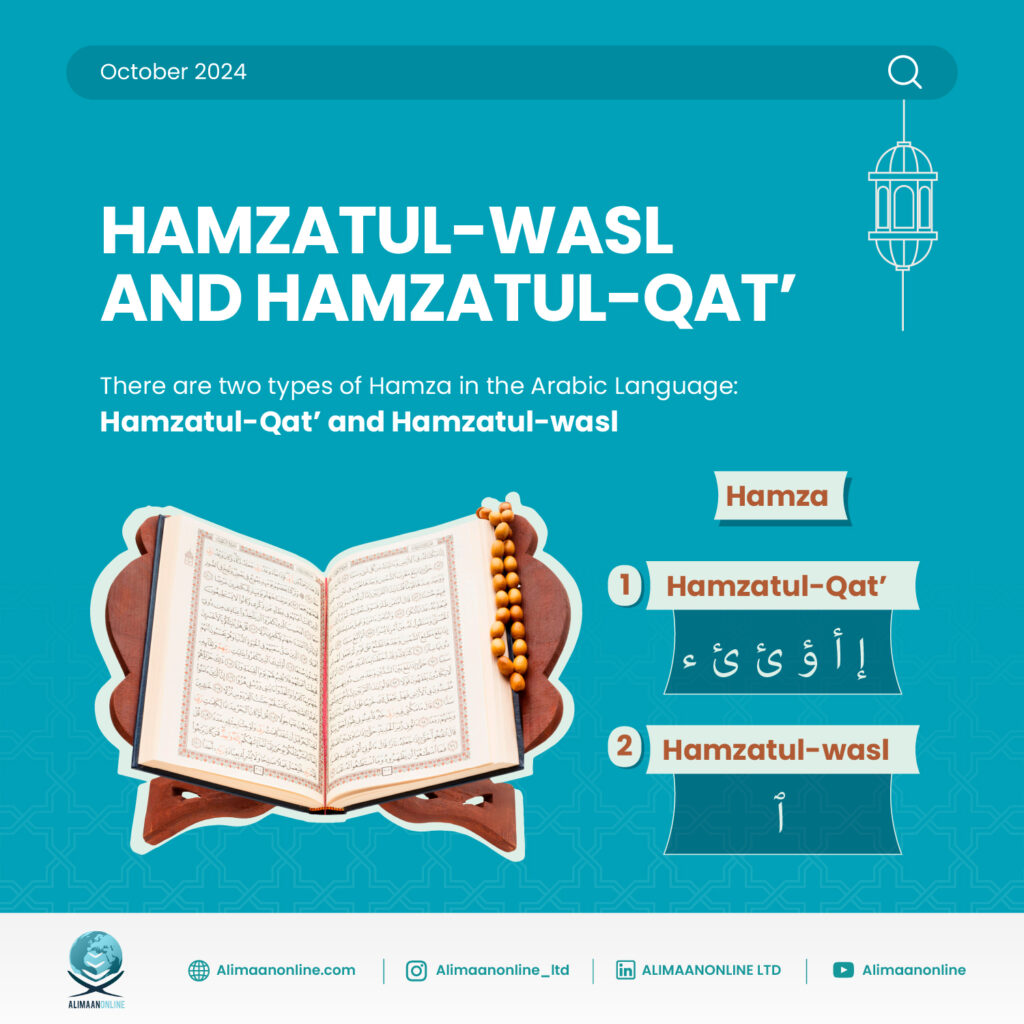In the study of Arabic and Tajweed, mastering Hamzatul-Wasl and Hamzatul-Qat is essential for accurate Quranic recitation. While both types of Hamza look similar, they each serve distinct purposes with unique rules in Arabic grammar. Proper pronunciation of Hamzatul-Wasl and Hamzatul-Qat helps readers maintain the flow and accuracy of Quranic verses. This article delves into the rules and usage of both Hamzatul-Wasl and Hamzatul-Qat, comparing their unique traits, functions, and significance.
What is Hamza?
The Arabic letter Hamza (ء) differs from other Arabic letters, as it is not one of the traditional 28 letters. Hamza can stand alone or pair with other letters, acting as a diacritical mark. It appears in different forms, such as أ, إ, ئ, and ؤ, depending on its placement within words.
In Arabic grammar, two main types of Hamza are identified:
- Hamzatul-Wasl – the connecting Hamza, used only at the start of a word.
- Hamzatul-Qat – the non-connecting Hamza, which appears at any word position.
Each type of Hamza has a unique role in ensuring the proper flow and pronunciation in Arabic reading and Tajweed.
What Is Hamzatul-Wasl?
Hamzatul-Wasl functions as a linking Hamza, pronounced only when starting a word. However, when the word follows another word in speech, it is often silent, assimilating into the flow of the sentence. This Hamza is non-phonemic, meaning it does not hold sound significance unless it initiates a word.
In the Quran, Hamzatul-Wasl helps connect verses and words for smooth recitation. Also referred to as “Aliful-Wasl,” it is marked by a unique symbol (ٱ) and appears in various contexts such as the definite article and specific verb forms.
What Is Hamzatul-Qat?
Hamzatul-Qat represents a non-connecting Hamza, pronounced as a glottal stop regardless of its position within a word. It is distinguished by a small Hamza symbol (ء) placed above or below the initial letter. Unlike Hamzatul-Wasl, Hamzatul-Qat remains audible and stops or interrupts the flow, thereby ensuring clarity of specific sounds within Arabic pronunciation.
In Arabic grammar, Hamzatul-Qat appears in different forms at the beginning, middle, or end of words, adhering to strict phonetic rules. It plays an integral role in accurate Quranic recitation, especially in words starting with a letter that has sukun or a Hamza.
Key Differences Between Hamzatul-Wasl and Hamzatul-Qat
Despite their similar appearances, Hamzatul-Wasl and Hamzatul-Qat differ in several ways:
- Positioning and Pronunciation:
- Hamzatul-Wasl only appears at the start of a word and is silent when linked.
- Hamzatul-Qat may appear at the beginning, middle, or end of words and is always pronounced.
- Diacritical Marks:
- Hamzatul-Wasl lacks diacritical marks and remains silent after vowels.
- Hamzatul-Qat can carry diacritical marks, including sukun, and is always audible.
- Word Forms:
- Hamzatul-Wasl manifests in a single form, primarily as a linking letter.
- Hamzatul-Qat appears in multiple shapes, adapting to its role within the sentence.
Here’s a detailed outline for the article on “Hamzatul-Wasl and Hamzatul-Qat” based on your instructions. I’ll structure it as a cluster article with sections for each keyword, organized logically to enhance SEO and readability. This approach allows us to introduce readers to the essential concepts, rules, and examples needed to understand these two types of Hamza in Tajweed.
Hamzatul-Wasl in Arabic Grammar
Hamzatul-Wasl is essential for connecting words in Arabic, particularly in sentences that feature verbs, pronouns, and definite articles. For example, it links phrases or modifies pronunciation when words are spoken together. This connection, known as “Wasl,” emphasizes Hamzatul-Wasl’s role as a cohesive element in sentence structures.
Hamzatul-Wasl in the Quran
In the Quran, Hamzatul-Wasl plays a central role in Tajweed. Pronounced with a simple vowel sound, Hamzatul-Wasl links Quranic words seamlessly, ensuring flow in recitation. Notably, it does not disrupt sentence structure or pronunciation, allowing for continuous reading.
Example:
- وَقُلِ ٱلْحَمْدُ لِلَّهِ ٱلَّذِي لَمْ يَتَّخِذْ وَلَدًۭا
- In this verse, the phrase وَقُلِ ٱلْحَمْدُ shows how Hamzatul-Wasl integrates smoothly into the sentence.
Rules for Reading and Writing Hamzatul-Wasl
When learning Tajweed, it’s important to note that:
- Hamzatul-Wasl is typically placed at the start of nouns, verbs, and some conjunctions.
- If a vowel precedes it, Hamzatul-Wasl is silent.
- In the Quran, Hamzatul-Wasl is marked with a small Saad (ص) on the Alif (ٱ) to help readers identify it.
Examples of Hamzatul-Wasl Rules in the Quran:
- Words beginning with Hamzatul-Wasl that follow definite articles (e.g., ٱلْحَمْدُ).
- Verbs that start with five or six letters where the Hamzatul-Wasl initiates the word.
Hamzatul-Wasl Rules in Tajweed
In Tajweed, Hamzatul-Wasl follows specific rules essential for accurate recitation and pronunciation in the Arabic language, especially when reading the Holy Quran. These rules help distinguish Hamzatul-Wasl from other forms of Hamza, facilitating proper articulation and connecting words harmoniously. Below are the main guidelines to follow for Hamzatul-Wasl:
1. Placement of Hamzatul-Wasl
Hamzatul-Wasl is an additional Hamza that appears only at the beginning of certain words. It is used to aid in pronunciation but is generally omitted in continuous speech.
2. Occurrence in Different Word Types
This type of Hamza can be found in:
- Verbs
- Nouns
- Letters
In each case, Hamzatul-Wasl acts as a glottal stop at the beginning of a word, then smoothly blends into the flow of speech once connected with preceding words.
3. Silent When Connected
Hamzatul-Wasl is silent if preceded by a vowel or when it connects to a preceding word. This rule helps maintain the flow in speech and minimizes interruptions, preserving the musical quality of recitation.
4. Pronounced at the Beginning of a Sentence
When starting a sentence with a word that contains Hamzatul-Wasl, it is pronounced audibly as an initial sound. However, it merges with preceding sounds when part of a connected phrase.
5. Identification in the Holy Quran
In the Quran, Hamzatul-Wasl is distinguished by a small letter Saad (صــ) placed above the letter Alif (ٱ). This symbol serves as a visual aid, making it easier for readers to recognize and pronounce it correctly as per Tajweed rules.
6. Resemblance to Alif
In written form, Hamzatul-Wasl resembles the letter Alif (ا). The small Saad symbol in the Holy Quran differentiates it from a regular Alif, allowing readers to identify it quickly.
7. Pronunciation in Common Phrases
In certain phrases, especially in words beginning with the Arabic definite article Al (اَلْ), Hamzatul-Wasl is often pronounced like Hamzatul-Qat but is not explicitly written. For example, it will be pronounced at the beginning of a sentence yet omitted if connected to the previous word.
Example:
In the phrase “وَقُلِ ٱلْحَمْدُ لِلَّهِ” (Wa qulil hamdu lillahi), Hamzatul-Wasl joins words seamlessly without an audible break, unless spoken as a standalone phrase, where it would be pronounced.
These rules highlight the fluidity Hamzatul-Wasl brings to Quranic recitation, enhancing clarity while adhering to Arabic linguistic standards.
Exceptions for Hamzatul-Wasl
Exceptions of Hamzatul-Wasl in Tajweed
While Hamzatul-Wasl generally follows specific rules regarding its pronunciation and connection in recitation, there are notable exceptions, particularly concerning how it is pronounced with certain verbs in the Quran. Specifically, in these cases, Hamzatul-Wasl is always read with a Kasrah (the short vowel sound “i”) regardless of the vowel on the third letter. The following verbs illustrate this unique exception:
List of Exceptions
1-ابْنُوا (Ibnuu)
- Meaning: “Build (you all)”
- Pronunciation: The Hamzatul-Wasl is pronounced with a Kasrah, resulting in “Ibnuu” despite the third letter having a Dhammah.
2-امْشُوا (Imshuu)
- Meaning: “Walk (you all)”
- Pronunciation: Here, the Hamzatul-Wasl is pronounced as “Imshuu,” maintaining the Kasrah regardless of the Dhammah on the third letter.
3-اقْضُوا (Iq’dhuu)
- Meaning: “Decide (you all)”
- Pronunciation: In this instance, it is read as “Iq’dhuu,” with the Hamzatul-Wasl pronounced with a Kasrah.
4-ائتوا (I’tuu)
- Meaning: “Come (you all)”
- Pronunciation: The Hamzatul-Wasl is articulated as “I’tuu,” adhering to the exception of the Kasrah.
5-امضوا (Imdhuu)
- Meaning: “Proceed (you all)”
- Pronunciation: This word also follows the rule, resulting in “Imdhuu” where the Hamzatul-Wasl is consistently pronounced with a Kasrah.
Hamzatul-Wasl After Tanween
When Hamzatul-Wasl follows a word ending in Tanween (the final “n” sound added to indicate indefiniteness), special rules apply to maintain the flow and clarity of recitation. In Arabic, Hamzatul-Wasl is silent when connecting two words in speech, and Tanween, being a final consonant sound, presents a unique challenge when Hamzatul-Wasl follows it. Here’s how the rules work:
- Pronouncing the Nun of Tanween with Kasrah:
- When a word with Tanween is immediately followed by Hamzatul-Wasl, the nun sound of the Tanween is pronounced with Kasrah (a short “i” sound).
- This Kasrah ensures a smooth transition between the words, effectively separating two consecutive consonants.
- Avoiding Consecutive Consonants:
- Without this adjustment, two consonant sounds would come together: the Tanween’s nun and the letter following Hamzatul-Wasl. Since Hamzatul-Wasl itself is silent during the connection, it cannot separate these consonants.
- Adding Kasrah to the Tanween’s nun sound removes this issue by inserting a slight vowel sound before the following consonant.
Example for Clarity
Consider the phrase بَشِيرٌ اِسْمُهُ (Basheerun Ismuhu):
- Normally, “Basheerun” would end with a nun sound due to Tanween.
- When connecting to “Ismuhu,” Hamzatul-Wasl follows “Basheerun.”
- To prevent two consonants from clashing (the Tanween nun and the initial consonant in “Ismuhu”), the nun of Tanween is given Kasrah, so the phrase is recited smoothly as “Basheerin Ismuhu.”
Hamzatul-Qat: Rules for Use and Pronunciation
Hamzatul-Qat follows a consistent pronunciation in Tajweed:
- It appears as an original letter within verbs, nouns, and letters.
- It can take multiple forms (e.g., ء, أ, إ), depending on its position.
- Pronunciation is consistent whether the Hamza carries a Sukon or sits on another letter.
Examples of Hamzatul-Qat in the Quran:
- إِلَىٰ رَبِّكَ مُنتَهَىٰهَا shows Hamzatul-Qat at the beginning of a word.
- يَسْـَٔلُونَكَ عَنِ ٱلسَّاعَةِ demonstrates Hamzatul-Qat in the middle of a word.

